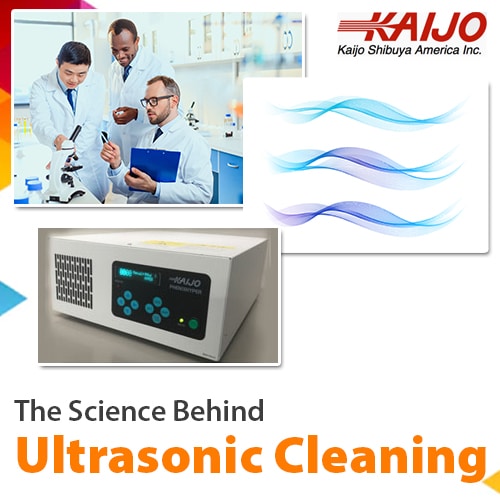The Science Behind Ultrasonic Cleaning
May 4, 2023
 Ultrasonic cleaning is an efficient and effective technique that uses high-frequency sound waves to remove contaminants from objects. Understanding the science behind how the technology works will enable you to achieve optimal results in various commercial and industrial settings.
Ultrasonic cleaning is an efficient and effective technique that uses high-frequency sound waves to remove contaminants from objects. Understanding the science behind how the technology works will enable you to achieve optimal results in various commercial and industrial settings.
The Basics of Ultrasonic Cleaning
Ultrasonic cleaning uses high-frequency sound waves (typically between 20-200kHz) to effectively remove dirt, grease, and other contaminants from surfaces. An ultrasonic generator produces an electrical signal which controls both frequency and power of an ultrasonic cleaning system. This electrical signal from the generator is transmitted to a transducer located in an ultrasonic cleaning tank, where it converts electrical energy into mechanical vibrations in the form of high-frequency vibrations. These vibrations travel through the liquid in a cleaning tank creating microscopic bubbles through a process known as cavitation.
The Science Behind Cavitation
One of the key scientific principles behind ultrasonic cleaning is cavitation. Cavitation refers to the formation of bubbles in a liquid due to rapid changes in pressure caused by ultrasonic waves. As the waves pass the cleaning solution, they create areas of low pressure that cause the liquid to boil up and form bubbles. These bubbles grow as the pressure continues to decrease until the point where they can no longer maintain their structure, causing them to collapse and implode under their own weight. When these imploded bubbles collapse, they generate high-pressure waves which agitate and dislodge contaminants from the surfaces being cleaned.
Bubbles created during cavitation are highly effective at reaching areas that are difficult to access with traditional cleaning methods. The bubbles generated by ultrasonic cleaners are small enough to penetrate crevices and other hard-to-reach areas, dislodging dirt, grease and other contaminants from these surfaces.
Frequency and Power Level
The ultrasonic generator plays a crucial role in controlling the frequency and power level of an ultrasonic cleaning system. The frequency of the ultrasonic waves determines the size and strength of bubbles created in the cleaning solution through cavitation. Lower frequencies from 20-40kHz produce larger bubbles with higher energy for cleaning heavy-duty contaminants. Higher frequencies between 80-200kHz produce smaller bubbles with reduced energy, making them better suited to delicate items or more precise cleaning applications. The frequency must be carefully chosen depending on your cleaning application needs.
The power level, commonly referred to as its amplitude or intensity, determines the strength of ultrasonic waves produced by a transducer. A higher power level allows more energy to transfer to the cleaning solution, increasing the cavitation effect and improving cleaning efficiency. However, higher power levels also generate more heat which could damage the tank or items being cleaned. Care must be taken in selecting and monitoring the power levels to maximize cleaning process efficiency and avoid damage.
Temperature of the Cleaning Solution
A key element that influences ultrasonic cleaning efficiency is the composition and temperature of the cleaning solution. Selecting an effective cleaner depends on the type of contaminants to be removed as well as the material properties of the objects being cleaned. Generally, higher temperatures increase cleaning effectiveness by decreasing the viscosity of the solution and promoting chemical reactions.
Advantages and Limitations of Ultrasonic Cleaning
Ultrasonic Cleaning Ultrasonic cleaning offers several distinct advantages over other types of cleaning methods. One of the most significant advantages is its superior cleaning efficiency. Ultrasonic waves can effectively clean hard-to-reach places like blind holes and crevices, removing contaminants that traditional cleaning methods leave behind. In addition, ultrasonic cleaning is a non-destructive cleaning method that can safely clean delicate objects such as lenses and electronic components without risk of damage.
Another advantage of ultrasonic cleaning is that it is environmentally friendly. As opposed to using chemicals or solvent-based methods for cleaning purposes, ultrasonic cleaners use water-based solutions which are safer for the environment and do not produce fumes or waste products. Plus, ultrasonic cleaning is quick and cost-efficient, reducing labor-intensive cleaning methods to save both time and costs!
Ultrasonic cleaning does have some limitations that should be considered. One limitation is that it has a limited penetration depth. Ultrasonic waves can only reach a few millimeters into materials being cleaned, which may limit their effectiveness for cleaning certain objects or materials. Ultrasonic cleaning could also damage some materials such as soft metals, plastics, and delicate electronic components, if the system is not properly controlled.
Another limitation of ultrasonic cleaning is its high initial cost. Ultrasonic cleaning equipment can be expensive compared to some traditional cleaning methods, and it may be practical for some smaller businesses or industries with limited budgets.
Get Expert Guidance with using Ultrasonic Technology
Selecting the right ultrasonic system, settings, and configuration for your cleaning requirements must be carefully considered. Kaijo provides expert guidance to ensure customers select an ultrasonic system that meets their cleaning requirements. Using Kaijo’s systems removes the complexity, risk and safety concerns from your industrial cleaning operations. Contact Kaijo for a complimentary consultation to explore how ultrasonics technology can be used for your application.





